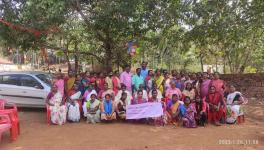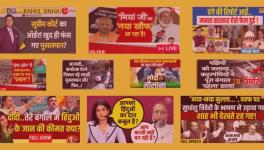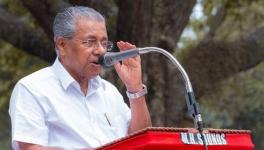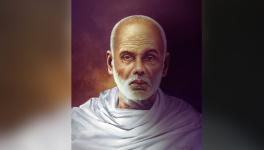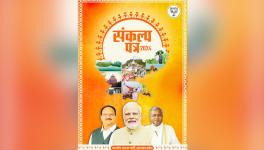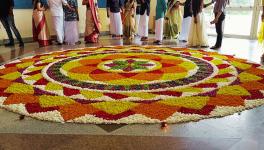Antigod’s Own Country
Senior journalist A V Sakthidharan's recent work "Antigod's Own Country: A Short History of Brahminical Colonisation of Kerala" takes us to the roots of the many non-Aryan deities and myths that dot the coast of Kerala – from Malabar's Muthappan and Pottan Theyyam to Travancore's Ayyappan and Malayali's own Maveli – their very existence, a resistance against invasive Brahminism and Aryanism. Traced through a telling exploration of the peculiar socio-political contexts that birthed these local gods or 'anti-gods', the book is also a deeply political meditation on issues faced by contemporary Kerala too. The work engages with Sabarimala, a religious space from where Dalits, Adivasis and other marginalised sections are increasingly being pushed out, as the book remarks. The Sangh's appropriation of Ayyappan – a non-Hindu, hill-top deity – is seen by Sakthidharan as an extremely political move, which seeks to purge this space of its pro-Dalit, pro-Adivasi, pro-Muslim character. The recent controversy on the entry of women of the menstruating age into Sabarimala is also placed against this context in the work.
Mukulika R of the Indian Writers Forum spoke to author A V Sakthidharan about his book, Sabarimala, the brahminical appropriation of Onam, and more.
Mukulika R (MR): What prompted you to write a book on the “antigods” of Kerala?
A V Sakthidharan (AVS): Mahabali, the benevolent ruler who lost his kingdom to the machinations of the gods, has attracted me since childhood. I found Suyodhana, who has a temple in southern Kerala, a noble character. Pottan Theyyam, who challenged Adi Sankaracharya on the caste system, is also a fascinating figure. Maveli and the Onam myth figured in our school text books and, of course, we had our Onam vacation. In Delhi, I came across Dalit Visions by sociologist Gail Omvedt, in which there is a chapter on Jotiba Phule, who had made “Baliraja” (Malayali’s Maveli) into an icon in his struggle against the caste system. To Kerala’s Marxist theoretician EMS Namboodiripad, “Mavelinadu” represented primitive communism. The several ramifications of the Maveli myth and the worship of non-Aryan gods in Kerala convinced me that there was immense scope for a book on this asura monarch.
MR: Onam seems to have become, more or less, a “hindu-ised”, brahminised festival, evident from the very symbols it uses – A “poonool” clad Mahabali being the most striking. There have been alternate imaginations of this character on social media, though not on a wide scale. What is the history of this and how do you think we can resurrect Onam and Mahabali from this appropriation? Secondly, what is your opinion on the section that feels the festival is to be entirely dismissed, for it appears “savarna”?
AVS: I don’t think there has been “hinduisation” of Onam. It is still a secular festival. Remember, BJP chief Amit Shah’s “Vamana Jayanthi” greetings ran into widespread criticism. Here, the asura is the hero. Further, in brahmin homes, ritual worship of deities is usually performed exclusively by men, but on the day of Thiruvonam, the most important day of the festival, the job is left to women.
Also Read: Antigod’s Own Country: Counter Culture in Kerala
There is, no doubt, opposition from some enlightened dalit groups to the celebration of Onam, which they dub a “savarna festival”. However, the fact is, it is the upper caste market that gave the “poonool” to Maveli in advertisements. The market has taken over the festival, which is inevitable, given the grip of a vicious consumerist culture on the Malayali min. If there has been hinduisation of Onam, it is only a sequel to its marketisation.
MR: You mention, very interestingly, in your book how the recent controversy regarding women’s entry into Sabarimala was not a singular incident but part of a long process of marginalisation of the downtrodden – Dalits and Muslims among others – from this religious space. Could you tell us more?
AVS: The tribal Mala Arayans claim that when the Sabarimala temple was under their control, until a century or so ago, there was no ban on the entry of women from the menstruating age group. It was brahmins, with their patriarchy, who constructed this taboo. Perhaps the location of the shrine in deep dissuaded women from undertaking the arduous Sabarimala pilgrimage.
In 1990, one S. Mahendran filed a petition in the Kerala High Court alleging occasional cases of violation of the ban on women’s entry. The court ruled in favour of the ban. In 2014, the Indian Young Lawyers Forum went to court challenging the ban. The rest is recent history. Meanwhile the temple authorities made the tribals and ezhavas give up some of their time-honoured rights—like the abhishekam by an Adivasi chieftain and the lighting of ‘makaravilakku’ by members of an ezhava family. The ban should be seen as part of this patriarchal upper caste package.
Also Read: “Classic texts, literary or sacred, are dynamic and responsive to their times”
MR: How dangerous is vedic Brahminism’s appropriation of ‘little’ traditions like Muthappan and why?
AVS: Mutthappan has been hinduised to a great extent. This appropriation will definitely kill the subaltern character of the deity. The Mathrubhumi’s Delhi edition had recently reported that in the shrine in Mayur Vihar, to which I have referred in my book, there is now a brahmin tantri. Where will this lead us to?
MR: The Sangh Parivar and other Hindutva forces have been on a homogenization spree in the country – be it their desire to impose a single national language or the abrogation of Kashmir’s special rights. How perilous is this for regional identities?
AVS: The Hindutva campaign of homogenization is unlikely to work in every field. Here is a country where – for all the talk of ‘Ramarajya’ – Rama is not worshipped in some regions and his mortal enemy has temples and ardent devotees in many states. There are also sizable minority communities. Coming to the imposition of Hindi, practically every regional language has its own individuality. Nor is Hindi a homogenous language; for firstly, it has diverse dialects. At the same time, because of the disunity in the ranks of the opposition, the Left in particular, we have no choice but to keep our fingers crossed.
A V Sakthidharan has worked as a journalist for close to four decades and retired from The Hindustan Times in Delhi as Assistant Editor in 2006. This is his first book.
Mukulika R is a member of the Editorial Collective at the Indian Writers Forum.
Get the latest reports & analysis with people's perspective on Protests, movements & deep analytical videos, discussions of the current affairs in your Telegram app. Subscribe to NewsClick's Telegram channel & get Real-Time updates on stories, as they get published on our website.









